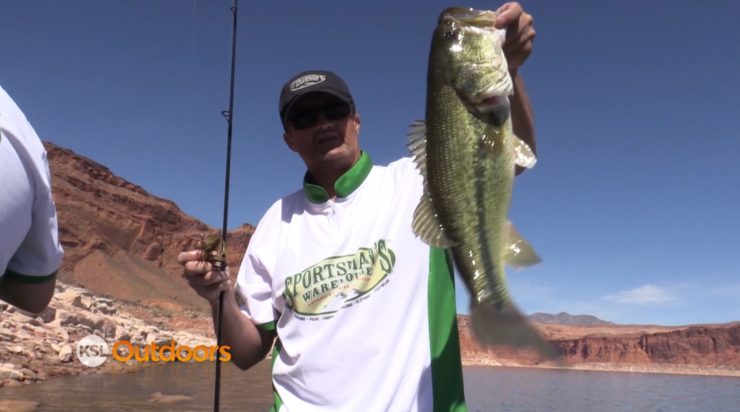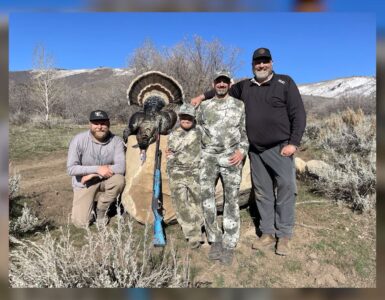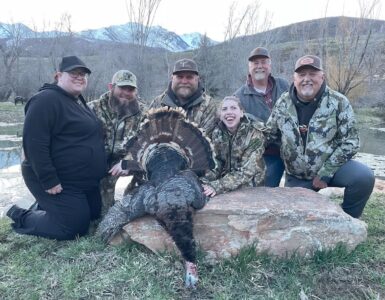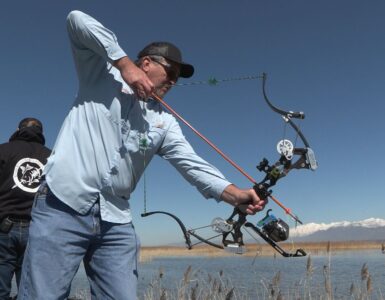Coming up tonight on KSL Outdoors.
oh it’s a good one too.
Some of the best fishing of the year is right now down at Powell.
the old Hula grub. That’s a three pound fish right there.
We’ll give you some insight on how to catch the big one and we’ll show you some disturbing video of the impact of quagga mussels.
I’m Adam Eakle and this is KSL Outdoors.
KSL Outdoors, with Adam Eakle, is brought to you by your local Ford stores.
Welcome to KSL Outdoors, I’m Adam Eakle and welcome to the new South Jordan Sportsman’s Warehouse. I’m here with Joe the store manager and Pete of course. How you doing pistol Pete. We are going to go fishing. We are, we are going to catch some fish Adam. Hey Joe, this store that just opened a few months ago, looks about half to three quarters the size of a normal store. Yeah we are about half the size of a normal store. We have all the key items that the regular store does in Midvale though.
We’ve got some lures that are guaranteed to catch fish. We can’t account for you Adam but they are good lures. We are going to show you how to rig them. We are going to do everything so you won’t be afraid to go to Lake Powell and have a great fishing trip. We are going after the big five down at Lake Powell. Some of the best fishing is going on right now. Let’s go hit the road.
This has become kind of an annual thing for us hasn’t it? It has, It’s always nice to get out of the cold country and come down here to Lake Powell when it’s warm in the spring and fish for some active fish.
Ryan is the Flaming Gorge Project Leader for the DWR, but every once in awhile he needs his Powell fix, as do I. We’ve picked a great day to fish, no wind, the water is hovering above sixty degrees and the fish are waking up.
Well we made it to Tapestry Wall this has historically been a good place for us to troll for both striper and walleye. A lot of times they are suspended here.
Trolling for those species just allows you to change up crankbaits, change up speeds, change up things a lot quicker and cover a lot of water and it can be really effective, we had a pretty good day today.
just as I picked it up a fish hit it.
We’re trolling our lures about one hundred feet behind the boat, at about 3 mph, our lures are running about 18 feet deep. Which is perfect because we’re marking fish around twenty to thrity feet.
What have we got? a walleye..no striper. little striper.
In terms of crankbaits for trolling, I really like walleye divers. Silver and black, silver and blue, orange peel, chartreuse and white, they work really well. We caught fish today on flicker shads.
There’s a fish.
Pretty simple to do and you can go fairly fast to. Yeah exactly and a lot of people troll to slow. Even some of the walleye we got today were on the outside board on a turn. we we’re trolling 3.2 I think when we caught a couple of those walleye. So that outside board is going 4 or even faster.
These fish are a little small. I think we are going to go and try some different tactics and try and catch some bigger fish. This is another walleye.
Little better walleye, not much though.
Trolling is a great way to find fish.
and it’s also a great way to get kids into fish at Powell because the boat does all the work. In short order, we caught four walleye and two stripped bass, but it was time to check in on Pete and Joe.
Oh yeah fish on baby!
Oh it’s a good one too. Fish on baby. Nice largemouth. do I dare swing him into the boat. Woo hoo, that’s a good fish.
the old hula grub, that’s a three pound fish right there. Beautiful fish. that’s what we like to catch, nice green fish. let’s let him go back to mama.
Pete is a lot of fun to fish with and he’s a knowledgeable Lake Powell Angler. The hula grub in green pumpkin or brown is one of Pete’s favorite lures here at Powell.
What that looks like to the fish is it falls this way and lands like that and it looks like a crayfish in a defensive position with their claws up trying to keep a fish from eating them and their legs down here. And you just walk it along the rocks and the best is when you walk it off the edge and it falls, fish can’t stand it, they’ve just got to eat it.
alright basically you want to cast in towards the rocks. Let it sink a little bit, then just tighten up your line a little bit, shake it and set the hook when a fish takes it. Just like that.
Right now we want to stay with the crayfish colors. In a few weeks to a month once the shad have spawned and you get the shad fry. I like to switch to this color which is a cream with a silver flake.
oh how about a small mouth bass. Oh it’s a good fish. Good fish boys, she’s a good one.
It’s Mr. Walleye! Woo hoo. Oh the hula grub? On the hula grub. Nice. That is your hula grub walleye. they taste good.
Coming up. Good crappie.
We’ll show you more species and we also show you what millions of dead, decaying quagga mussels look like on the red rocks of Lake Powell and what every boater must do and know. That just ahead, but first tonight’s Burt Brothers quiz question.
Construction on Glen Canyon Dam took nearly ten years to complete. But in 1964 the dam was done and Lake Powell began to fill. Lake Powell is the second largest man-made reservoir in the country with a storage capacity of twenty-seven million acre-feet. Our Burt Brothers quiz question tonight is. Can you name the major tributaries that fill Lake Powell? The answer when KSL Outdoors powered by Ford returns to Powell.
KSL Outdoors is also brought to you by Fish Tech Outfitters, Utah State Parks, Burt Brothers, Sportsman’s Warehouse, Evanston Wyoming, and Camp Chef.
Welcome back to KSL Outdoors, I’m Adam Eakle back here at Lake Powell. Well it’s morning, it’s day two of our Lake Powell adventure. That in a moment, but first our answer to our Burt Brothers quiz question.
and our question is.
Can you name the major tributaries that fill Lake Powell? Here’s the answer. Although many of Lake Powell’s 96 major side canyons supply some water to the reservoir. There are three major tributaries to Lake Powell. The biggest is the Colorado River, then you have the San Juan River, and then, the Escalante River. Right now there are over three point six trillion gallons of water in Lake Powell! Crappie. Good one. Oh there you go, that’s a crappie. That there is a crappie, good crappie. (lift into boat)
That’s a good one there. Probably pushing close to two pounds. Yeah, that’s probably the biggest crappie I’ve ever caught.
At one time, crappie and largemouth bass dominated the catch for Lake Powell anglers. Long gone are the days of flooded brush along most of Lake Powell’s shoreline. With that loss of brush, young crappie and largemouth bass lose the ability to hide from predators. So, the population of those two species fluctuate as the water rises and falls at Powell. Both species are rebuilding right now, but you can still catch a few.
there he is. It’s a good something.
largemouth, that’s the one we wanted.
taking line, a couple of pounds. Oh yeah. that’s the one I saw.
Nice fish missed him twice, but we got him finally.
Big old pretty bass, look at that, a couple of pounds. Nice largemouth.
Crappie!
We are trying to catch some crappie here. We are fishing this flooded timber and you know the crappie will hang out around the trees. They are probably in a spawning mode.
Probably one of the most pretty fish here at Lake Powell I think. Black crappie, I grew up as a kid catching those. Look at the blues on the top of that fish.
I’m going to put him back.
Right now I’m using a little bobber and I’ve got just a little jig underneath. About four feet underneath the bobber. Trying to get it as close to the main trunks as you can because those crappie will hold suspended right on the main trunk.
We found crappie in the trees in the back of Halls Crossing, the canyons of Forgotton and Knowles and in Good Hope Bay.
fish on! Crappie!
Fish slab, little crappie. That’s a little bit better one, almost worth keeping.
there’s a fish! good fish too.
But by far the most abundant sportfish in Lake Powell
is the hard fighting, bull headed smallmouth bass.
You can see how fat she is, she’s probably a female getting ready to spawn so we probably are going to put her back. don’t want to kill a bunch of smallmouth eggs, although that size is about the threshold, about the edge of it. Get him back in.
Wayne Gustaveson the Project Leader for the DWR at Lake Powell encourages anglers to keep a few of the ten to twelve inch smallmouth to keep the population in check and we did. But it’s hard to keep those fish when they are in the midst of their spawn.
Ok, we’ve got a bed here.
there he is got him.
Right now is a great time to spot bedded bass. Look in clear water anywhere you find gravel near the shore. Oftentimes the bass will hit any lure thrown near or in the bed. Lake Powell water is slowly rising, so these beds can be found in two feet or up to eight.
It’s really fun to catch these guys on their beds, but that little buck right there is protecting that bed. Normally we’d eat him and Wayne would probably agree to keep him and eat him because there is enough smallmouth in the lake, but he’s doing a good thing so we are going give him a kiss and let him go and watch him go right back to that bed.
More from Lake Powell in a moment, but first back to the guys at Fish Tech for tonight’s fishing report.
Hi George Sommer here with Fish Tech Outfitters. Today we are going to talk about how to Texas rig a bait fishing for bass in heavy cover. I guess the first thing to look at here is the outfit. I’ve got my hook, my sinker and then I use a little rubber thing called a Peg It there. That will trap my, when I pull it tight my sinker against my lure. Then I am not leveraging that sinker to pull the hook into the cover. To Texas rig a bait, take your tube, your grub or whatever you are using. Start it at the top go out about a 1/4 of an inch, take the point up and through, there’s a little keeper on the hook for that and then you are going to going to pull it all the way through and then just skin hook it. So it’s weedless when it comes through here, but when a fish bites it, it pops that hook open and you’ve got him. You can use this on tubes, on grubs, creature baits, another good way of doing it is on a fluke. These can be used for bass over heavy cover, they can also be used for trout. I’ve got it rigged up here. I rigged it weightless. I’ve done the same thing. I’ve got it skin hooked so that when the fish bites it, it free and you’ve got them. For tips and techniques like these and many others, stop in and see us at Fish Tech Outfitters and now for tonight’s fishing line.
Welcome back to Lake Powell. It’s been a few years now that quagga mussels have been confirmed in Lake Powell. Last February, Wayne Gustaveson with the DWR released video he shot in Navajo Canyon in the southern end of the Lake. It was gut wrenching for people like myself who have recreated at Lake Powell for decades. Millions of dead quagga mussels clinging to the canyon walls.
Yeah I mean it’s scary. Kind of knew it was going to happen, but it made it real. I was down on the lake a couple of weeks later, down in Castle Rock Cut through and saw quagga mussels myself and it’s just disappointing. it’s going to change the fishery. It’s gong to change the way we recreate on Lake Powell. The days of walking barefoot on sandy beaches could be gone.
Our biggest priority in Utah is still Lake Powell. Because of the infestation down there. We do have Deer Creek along the Wasatch Font that is classified as a suspect water.
Nathan Owen, the Aquatic Invasive Species Coordinator for the DWR says boater boaters can expect containment measures at both Lake Powell and Deer Creek this summer.
Those basically include technicians on the ramps. Intercepting exiting boats. Talking with the boat owners, Inspecting those boats for any attached mussels and helping the boat owners draining all water from those boats. ballast tanks, live wells, bilges areas, making sure they are not transporting water out of the immediate area. Once they confirm all water has been drained they are actually tagging all exiting boats with this orange seal.
Once this seal is attached to your boat, you will not be allowed to launch that boat on any other water until your boat has met the mandatory dry time requirement for the state of Utah.
The other option is if you know that you are going to be launching your boat anywhere in Utah before being able to meet that required dry time. You can tell our technicians and in most cases we will try to decontaminate that boat on the spot before you leave that immediate area. Sometimes that is not possible due to the number of boats exiting at any given time but we make every attempt to do so.
The last thing I want to do is move them to any other body of water, just like any other angler or recreationists I hope
You’ve got to police yourself in a lot of ways and just make sure you are not transporting this invasive species to other bodies of water.
Aside from the decontamination stations here at Lake Powell, the best we can do as boaters is follow three simple rules. Clean, drain and dry your boat. You know in the Spring it’s 18 days, in Summer it’s 7. If you have any questions go to STDOFTHESEA.com. and educate yourself so we don’t ruin another lake, reservoir here in Utah. Time now for tonight’s Utah Field Guide.
Sometimes known as the sea hawk, fish eagle or fish hawk, the Osprey, like this pair we found in the back of Hall’s Crossing, is a large raptor that feeds primary on fish swimming at or just below the water surface. Ospreys have vision that is well adapted to detecting underwater objects from the air. Prey is first sighted from the air, after which the bird hovers momentarily then plunges feet first into the water.
did he get it? yup.
that was impressive. that was a good fish. that was a nice rainbow.
The Osprey is particularly well adapted to a fish diet, with reversible outer toes, closable nostrils to keep out water during dives, and backwards-facing scales on the talons which act as barbs to help hold its catch. Osprey’s are found pretty much statewide. Flaming Gorge is probably the best place however to find and to view this spectacular bird.
For more information on the osprey be sure to check out our Utah Field Guide on our outdoors page at KSLTV.com
Boy even in early May make sure your bring plenty of sunscreen down here. It is only probably nine in the morning and it is already heating up. It’s hot but beautiful up here. Hey let’s find out that recreation forecast now by turning it over to Kevin, back in the weather department.
Welcome back to KSL Outdoors, back here at Lake Powell. Don’t forget if you are looking for some ideas on how to get your family into the outdoors, maybe the Lucerne Valley Marina that is coming up or how about Free Fishing day in June. For all those and many more events check our outdoors calendar page at KSLTV.com
Boy I have a lot of memories back here in Halls Creek with my dad growing up. Going back in here I think it’s the old Johnson’s Ranch is back in here. Hiking up to the waterfalls here in Halls Creeks when we were kids. A lot of old cool memories. Boy make sure when you are out with your kids this summer, take a lot of snapshots of your fond memories and submit them to our snapshot contest. Now time to turn it over to you for the best of the week, our snapshot of the week.
This is the luckiest hunter in the Olsen family, young Levi. This is his second turkey tag in two years and he bagged a bird both times. This hunt was a family affair, they had the blind put in just right spot as they were able to watch the birds come out of the roost and eventually right by the blind where Levi bagged his second bird at twenty yards. Having all the kids there is awesome.
Check out Kalebs first mule deer he took last year and he got it with his bow. Dad says Kaleb practices a bunch, was very patient, in fact he had to hold still for about thirty minutes to get a shot on this public land deer and dad couldn’t be more proud.
Tony took the Hulse boys out for nice Sunday drive and ran into something pretty unique. This albino mule deer. Tony told the boys that they never would have had this experience at home, playing on their phones. It’s amazing what you can see when you get out and enjoy where we live.
Roy and his son Cameron went to Bountiful Lake for an evening of fishing. Roy says, this is what they had to “suffer through” that evening, this beautiful sunset. He says it was a “terrible” thing to have to look at while standing there with a fishing rod in your hand. A great shot Roy.
but our winner tonight actually was able to learn a bit from his little brother. Houston says he has many fond memories hunting with his little brother Bryan. But, on this hunt he was the student and Bryan was the teacher. They were hunting down on the majestic Tushar range when his brother and his brothers friend Austin put Houston in just the right spot to bag this beautiful bird. This Bryan says is another wonderful hunt with his brother he will never forget. Well congrats Houston on a great bird, a great bond and now our great prize, that you may want to share with your little brother, as you just won our snapshot of the week.
Remember submit your pictures or video, plus an explanation of your latest outdoor adventures online at KSLTV.com. The winner each week wins a commemorative, 100th anniversary National Parks cast iron dutch oven and skillet and the winner is also entered into our Ford Trucks quarterly Facebook giveaway for a Camp Chef Pellet Grill.
Whether in the backcountry or the great outdoors, Camp Chef, it’s the way to cook outdoors.
The one thing I forgot to mention is Senko’s. I fished senkos quite a bit and caught some really nice largemouth on the senko, so that was a good thing. I think the senko, I don’t know why it is, but I think they seem to catch bigger fish. They do and they definitely work and I caught some really nice largemouth on them but you know on the jigs, throwing the pumpkin color jigs I caught three walleye on the pumpkin colored jig just fishing for bass so shows you how many walleye there are in this lake. There’s a bunch. Hey I need to bring that deer to your store. My wife won’t allow it in the house. Ok, bring it down. We’d love to have it at there. All the fans of Adam Eakle can see his deer at the South Jordan Sportsman’s Warehouse, yeah that my wife won’t let me put in the house. Biggest deer I’ve ever killed, love you honey. Hey I’m Adam Eakle, for Joe and Pete, all the guys at Sportsman’s Warehouse in South Jordan, reminding you to get out with your family, your friends and make some memories, like a spring trip down to Powell outdoors. We’ll see you next weekend, goodnight.
















Add comment